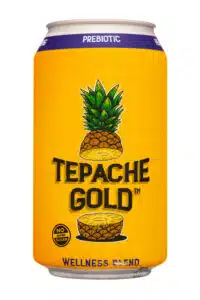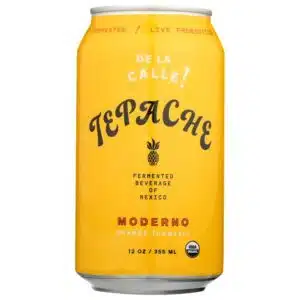Have you heard of Tepache? This traditional drink of Latin America happens to be a fizzy delight and good for you too! Once we discovered it, we were obsessed!
AFTER Magazine sat down with Jorge Cruz, co-founder of Tepache Gold, who shared how his family made tepache when he was growing up in Mexico, and taught us about the origins of tepache and the process of making this tangy, healthy beverage.
Tepache dates back to the Aztec (also called the Nahuati) civilization in modern-day Mexico. Its name comes from the Aztec word tepiatl meaning “fermented corn.” Today Tepache is made with fruit—usually the rind of a pineapple, although other tropical fruits including soursop (guanabana) are also popular. The beverage is made in homes across Mexico and Latin America, and is available at roadside stands, from horse-drawn carts, and at markets across the region.
Cruz and his business partner, “Lefty,” were inspired to create a ready-to-drink tepache in the United States when they saw a pineapple rind about to be thrown away at a barbecue. Cruz says, “I thought, ‘I should make tepache out of that.’ At home we wouldn’t waste anything. Everything gets used.” From this experience (and a year’s worth of reasearch and planning) the brand Tepache Gold was born.
This refreshing drink has a bit of a kick and is filled with pre- and pro-biotics, which are beneficial to gut health and digestion. It’s delicious on a warm day alone or with a splash of alcohol-free rum as recommended by Cruz.
Make Tepache at Home
Cruz generously shared the ingredients his family uses in their tepache with us so we could learn more about how this beverage is traditionally made. With his blessing, we’ve added our own quantities and guidelines below if you want to try the process at home. (Also see below for a few delicious, commercially available options!) *
Homemade Tepache
Serves: 1
- Rind and core of one pineapple
- 4 1/2 c water
- 1/2 c panela (a.k.a. piloncillo), which is the traditional sugar used in Mexico and Latin America—or brown sugar
- Flavorings, to taste, including cinnamon, clove, ginger, or orange peel
- Add the water, sugar, and spices to a saucepan, and stir until the sugar is dissolved.
- Let cool, then add the peel and core of the pineapple.
- Loosely cover and let the mixture sit at room temperature up to four days.
- After four days, skim off any foam, strain the solids and place the beverage in the refrigerator to stop any additional fermentation.
Ingredients note:
Choose an organic pineapple if available. The natural yeasts on the pineapple’s surface are part of what allow it to ferment. You want to retain the yeasts without introducing pesticides to the beverage.
A note about alcohol:
Like all fermented beverages, homemade tepache contains a small amount of alcohol, similar to kombucha, generated in the fermentation process. At four days the amount is negligible but fermenting longer will create higher levels of alcohol.
The two commercially made tepaches below do not contain alcohol and are a better choice for those who do not tolerate trace amounts of alcohol. In this case, the fermentation is done separately to add the tanginess of fermented ingredients without the alcohol.
Try it for yourself:




